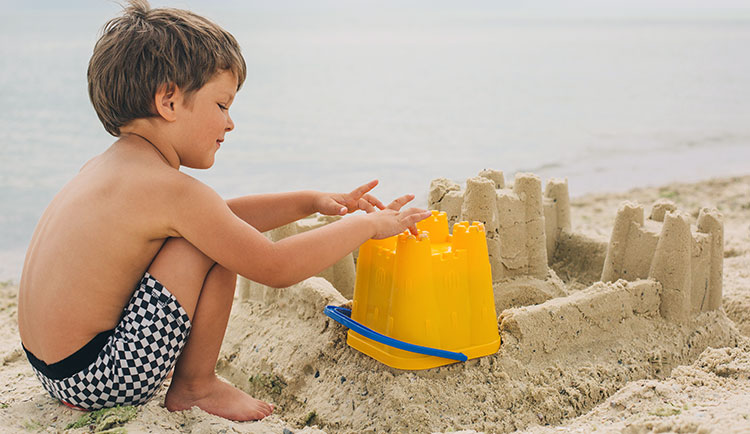C2: Introducing Sentences: What’s Happening
1. Overview
Review what a sentence is and learn to identify both parts of a sentence: who it’s about and what’s happening. This activity will focus on identifying the what’s happening part of a sentence, also known as the predicate. Use these terms consistently throughout this module so your child does not get confused:- sentence
- who it’s about
- what’s happening

“Stewart made a sandcastle at the beach.”
Tell me the what’s happening part of that sentence.
2. Materials
For this activity you will need a list of the sentences you created and wrote down from Introducing Sentences: Who It’s About (W1). ↑ Top3. Activity
Video: How to play Introducing Sentences: What’s Happening
Start by reviewing with your child a simple explanation of what a sentence is and the who it’s about part.
Adult: Let’s review for a minute. Can you tell me what a sentence is? Child: A little story! Adult: Yes, a very little story. Do you remember how many parts a sentence has? Child: Two! Adult: Yes, two! A sentence has a who it’s about part AND a what’s happening part. You have been doing a really good job of finding the who it’s about part of my sentences. Now let’s see if you can tell me the what’s happening part of the sentences — the little stories — that I say.Start with one of the sentences you made up about your child in the previous activity.
Adult: Let’s repeat a little story about you. Listen: “Logan swims at the pool.” What’s the little story? Say it. Child: Logan swims at the pool. Adult: Yes. “Logan” was the who it’s about part. “Swims at the pool” is the what’s happening part. It tells what Logan does. Let’s try some more sentences, and you tell me the what’s happening part.Give the child at least 10 sentences that have the child’s name as the who it’s about part. Each time, ask him to say the words for the what’s happening part. After each sentence, review the child’s answer.
Adult: Here’s another sentence: “Logan zips up his coat.” You say it. Child: Logan zips up his coat! Adult: Now tell me the what’s happening part of my sentence. Child: Coat! Adult: Almost. The what’s happening part is “zips up his coat.” “Logan zips up his coat.” Tell me the what’s happening part of the sentence. Child: Zips up his coat. Adult: Yes. “Logan” is the who it’s about part, and “zips up his coat” is the what’s happening part.Repeat this with more sentences about the child. Once he shows a good grasp of the activity, use the list of sentences you made for Activity C1 that has a different subject than the child’s name.
Adult: Now let’s see if you can tell me the who it’s about part and the what’s happening part of some different sentences. Listen: “Daddy ate a sandwich.” Say that. Child: Daddy ate a sandwich. Adult: Tell me the what’s happening part of my sentence: “Daddy ate a sandwich.”Go through at least 10 sentences in a session. After each example, restate the point of the exercise:
Adult: You listened to my sentence and told me the what’s happening part in each sentence — each little story — I said.NOTE: Be sure to make up sentences that have action verbs in the past, present, and future tenses. ↑ Top
4. Confidence Builder
If your child is struggling, repeat this activity daily, using three or four sentences about your child. For best results, follow the script above closely. ↑ Top5. Small Groups (2-5 children)
Lesson Objective: Children will be able to identify the “what’s happening” part of a sentence. GELDS (Georgia Early Learning & Development Standards): CLL6.3d (Activities for this standard will be increased in difficulty to match children’s age.) Georgia Standards of Excellence: ELAGSEKSL2 Common Core State Standards: CCSS.ELA-LITERACY.SL.K.2 Additional Materials:- the sentences you created in activity C1 and/or a storybook list of sentences, cut into strips with individual sentences
Leave a Reply
